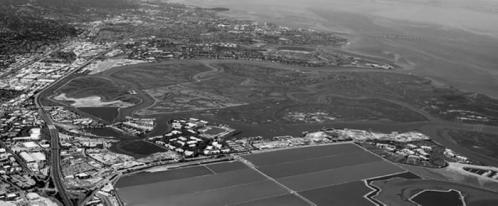
Of the nearly 60 Fortune 1,000 companies in Northern California, only one-third of them are based in our megaregion’s central cities of San Francisco, San Jose, Sacramento and Oakland. This sprawling pattern of job growth poses great challenges as the boundaries of the megaregion expand outward, resulting in unsustainable commute patterns and increased levels of greenhouse gas emissions. While many key industries of our megaregion’s economy are now based in these car-oriented suburbs, this sprawling pattern of employment must change if we wish to meet regional and statewide targets for addressing climate change.
In particular, the recent California state Senate bill 375 aims for transportation planning that reduces driving through better-coordinated land use planning. While the bill specifically discusses planning for housing, it is just as important for employment. We will not be able to reduce daily driving unless we investigate the matter of where jobs are located, and develop effective strategies to shift more work to locations that can be served by regional public transit.
In addition to its impact on the environment, the location of jobs is a key variable in the economic competitiveness of our regional economies. Long commutes on congested freeways reduce productivity. The spread-out pattern of work makes job access a challenge for people in lower-income households, who have fewer choices of where to live. Yet dense employment districts benefit employers as they share ideas, workers and clients. Proximity to other businesses — particularly in related industries — is an important factor in a firm’s competitiveness. This is best achieved when jobs and businesses are concentrated into centers.
This article outlines the problem of job sprawl, and offers a framework to address it. Our overall goal is to slow the continued outward growth of jobs from already developed employment centers, and to shift more commuters — wherever they work — into sustainable commute modes. We propose a four-part land-use solution to:
- Shift more work back into traditional transit-served downtowns, such as the central business districts in San Francisco and Oakland.1
- Concentrate more employment at suburban transit stations in "edge cities" such as Walnut Creek, Concord, Sunnyvale and Mountain View.
- Remake existing low-density office parks and scattered office buildings along highway corridors into higher density employment districts with the potential to be served by transit.
- Reform the self-enclosed, car-oriented corporate campus into a more sustainable model that may include increasing employment density while also bringing in other uses, additional shuttles and new transit.
Achieving these four goals requires policy interventions that shift the incentive structure for employers, developers and individual commuters.
Ultimately, we envision a polycentric megaregion where the various employment centers serve different roles, yet are all connected in a transit network. The shifting of work to transit-served areas reinforces each center (including the traditional downtown) as more businesses become connected to each other. This vision recognizes the multi-centeredness that is a permanent feature of our megaregion, but tries to reshape this geography for a 21st century in which non-driving alternatives are increasingly important.
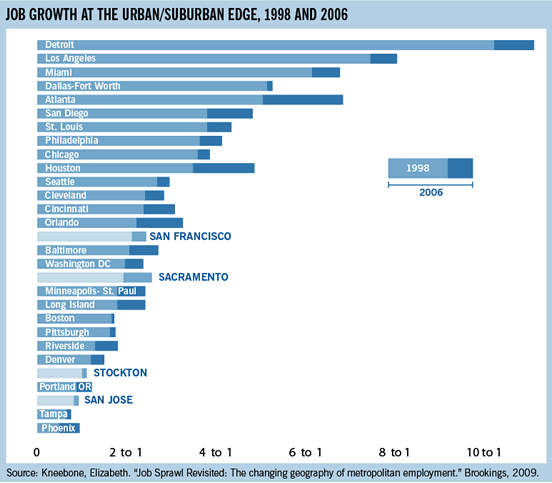 This graph is a jobs index comparing the jobs located more than 10 miles from CBDs to jobs located within three miles of CBDs. The dark blue sections show the difference in this ratio between 1998 and 2006. (For instance, the ratio for Phoenix is 1:1, meaning Phoenix experienced 100 percent more growth at its urban boundaries than it did in its city center.) The lightest areas show the values for cities within the Northern California megaregion. <!--EndFragment-->
This graph is a jobs index comparing the jobs located more than 10 miles from CBDs to jobs located within three miles of CBDs. The dark blue sections show the difference in this ratio between 1998 and 2006. (For instance, the ratio for Phoenix is 1:1, meaning Phoenix experienced 100 percent more growth at its urban boundaries than it did in its city center.) The lightest areas show the values for cities within the Northern California megaregion. <!--EndFragment-->
Why the suburbs don’t have to sprawl
Suburbanization, or the outward movement of people and economic activity from central cities, has been a persistent feature of urban settlement for centuries. It is neither a contemporary problem, nor an issue specific to a certain city or country. But while every economically prosperous city in history has extended its boundaries by adding new residents and work settlements on its urban fringes, the first signs of suburbanization hardly resembled the low-density, auto-dependent and placeless pattern of development that we now know as sprawl.
By contrast, in the 19th century the suburbanization process was a logical extension of the city itself. While places like Brooklyn, New York and Lake View Township north of Chicago were initially located outside of the traditional city, by 1900 they were annexed by the growing city and no longer considered suburbs. Around the same time, many cities extended electric streetcar lines to residential communities called “streetcar suburbs.” These places were characterized by a streetcar connection through a main street commercial district. Parts of the inner East Bay such as Berkeley, Piedmont and the Rockridge neighborhood in Oakland were all streetcar suburbs. While these places today are praised for their liveliness and walkability, they facilitated an outward growth of metropolitan areas that helped fuel sprawl with the rise in private automobile ownership.
A more car-oriented era of suburbanization followed the declining use of streetcars. Before World War II, rising rates of car ownership fueled the development of suburban strip malls and manufacturing plants. (The issue of ‘whether jobs follow people or people follow jobs’ still remains unresolved. Some argue that the industrial jobs first left the city and then people followed the jobs — this was certainly the case for many of the Bay Area communities that grew to support shipbuilding industries during World War II.) Manufacturers were attracted to lower land and labor costs (particularly with the increasing advent of assembly lines) outside of city centers. And with the introduction of trucks, they no longer needed to be in city centers to utilize lower freight costs.
This pattern accelerated with the widening availability of homeowner subsidies and massive investments in highway infrastructure in the decades after WWII. Still, the most dramatic shift of employment centers occurred after 1970, particularly in office functions that had previously been located in downtown central business districts. As new service industries developed, locating employment in CBDs became unnecessary and expensive since most of the work could be done in remote office spaces using telecommunication technologies. As a consequence, many films built back offices in suburban sub-centers.
What is job sprawl?
Over the past few decades, employers have followed residents to the suburbs as the share of jobs in central cities has declined. In fact, most workers now live in one suburb and work in another, rather than commute back to the city. This process of job decentralization is the key factor that has facilitated job sprawl.
Yet what we call "job sprawl" is simply the spread-out organization of work into locations where the density is too low or that are too poorly designed to be effectively served with transit. As a result, the vast majority of commuters drive to work. Put most simply, the primary problem with job sprawl is that as work decentralizes, it puts more jobs in non-transit-served locations and means most commuters are unable to access work without a car.2
By contrast, when most jobs are in the core of a region, the "commute shed" — or the geographical area from which a region’s commuters originate — is fairly contained, and a higher percent of all commuters have overlapping commutes. Not only do most commuters live within a reasonable distance of their job (a commute of approximately 30 minutes), but many of them also have similar commutes, thus making transit investments highly effective.
But as more jobs move to the suburbs, each new job site has its own distinct commute shed. Suddenly, a "reasonable" 30 minute commute to this new suburban location can include a much more remote community now at the edge of the region. Because many of the edge communities have few economic development options, they often have city councils that are distinctly pro-growth and therefore willing to accept any development. In a region such as the Bay Area, where many of the core communities are generally anti-growth, pressure at the edge becomes even more intense. For example, as more work shifted to Concord and Livermore in the East Bay, commutes from places such as Brentwood, Antioch and Tracy became much more reasonable. The same holds true for job-rich Sacramento suburbs such as Rancho Cordova and Roseville, which makes living in the Sierra foothills viable.
Yet it is not the outward movement of jobs alone that is the problem. Instead, it is the disorganized, low-density form of employment that forces most people to use a car to make the trip between home and work. The more job locations there are, the harder they will be to serve efficiently with transit, particularly when the region’s commute patterns begin to look more and more like a spider web. In this situation, the most effective way to get from one place to another (or from home to work) is the private automobile. Public transit can almost never work where job density is too low and the residential origins are too scattered.
Over time, this process becomes self-reinforcing. As more jobs move to the suburbs, the commute sheds become more stretched out, and the edge sprawls farther out into farmland or natural habitats. And as workers increasingly move farther toward the edge of the megaregion, more employers will follow them and continue to perpetuate this cycle.
Today, the suburbanization of work is now a key driver of residential sprawl as the commute shed defines the edge or boundary of a megaregion. Reversing residential sprawl necessitates stopping job sprawl. Yet with more than half the U.S. population now working in the suburbs, stopping job sprawl is no longer about limiting the movement of work to the suburbs, but instead about reorganizing work within the suburbs to better meet the needs of a sustainable region.
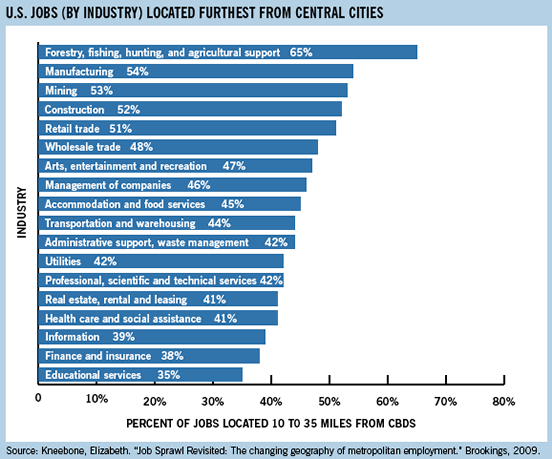
Many of the jobs facing the highest decentralization rates nationally are key industries in the Northern California megaregion. For some industries, such as transportation and warehousing, decentralization is not surprising. But why are industries such as management, information and education moving away from central cities?<!--EndFragment-->
Why job sprawl is getting worse
As evidence that job sprawl is getting worse, we analyzed three trends: the decentralization of jobs, declining transit commute patterns, and increasing congestion and vehicle miles traveled.
Trend #1: There has been significant increase in job growth outside traditional downtowns
Since the 1990s, the share of jobs located within three miles of central business districts has steadily declined. Based on an analysis of the decentralization of work from the four central business districts or primary downtowns of Northern California (San Francisco, San Jose, Sacramento and Stockton) during the eight-year period between 1998 and 2006, these CBDs experienced a net loss of more than 22,000 jobs, while jobs located 10 to 35 miles from these CBDs increased by more than 225,000.
Nationally, job growth out from the center has become a significant trend. Of metropolitan areas with more than 900,000 jobs within 35 miles of the central business district, all have experienced a decline in the share of jobs within three miles of the CBD and an increase in jobs 10 to 35 miles from the CBD.
Also, the rates at which jobs move outward in certain industries in the United States are increasing. Nationally, some of the most rapidly decentralizing industries are the same industries that are most important to the Northern California economy, and particularly to its traditional central business districts. Industries such as management, information services and education are experiencing the greatest share of relocation to areas 10 to 35 miles from CBDs. While it may not be surprising that manufacturing, transportation and warehousing are moving out into the suburbs and beyond, the trend of less cost-sensitive industries (for instance, knowledge services such as management of companies and finance) moving out poses yet another challenge for traditional downtowns, given that these are industries where the CBD is also most competitive. For example, nationally, 46 percent of jobs in "management of companies" and 42 percent of jobs in professional, scientific and technical services are located 10 miles or more from a traditional CBD.3
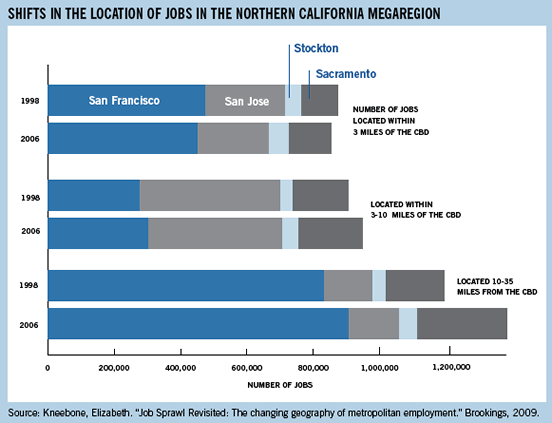
Over the last 8 years, central business districts in Northern California have lost over 22,000 jobs. Meanwhile the number of jobs located 10 to 35 miles from the CBDs has increased by over 225,000 (that’s more than half the number of jobs in downtown San Francisco).<!--EndFragment-->
Trend #2: The number of commuters who drive alone to work has increased dramatically.
The share of commuters in the Northern California megaregion who drive alone to work has been increasing since the 1980s. Even in San Francisco, where transit ridership is historically and significantly higher than elsewhere in the megaregion, the share of commuters who drive alone has grown. This increase is in part due to the movement of jobs from urban cores to suburban office parks that are not as easily accessible to transit. It is also due to the growing number of professionals living in San Francisco and commuting to information and technology jobs in the Peninsula and South Bay.
Among counties in the Northern California megaregion, San Joaquin County in the Central Valley and San Benito County south of Santa Clara County stand alone in experiencing a decline in the share of drive-alone commuters — due in no small part to the advent of transit access in these areas. San Joaquin County saw a significant increase in transit ridership following the 1998 creation of the Altamont Commuter Express, which links Stockton to San Jose with daily rail service. San Benito County also experienced an increase in the number of commuters who use transit to get to work, once Caltrain was extended to Gilroy in 1992 and transit from San Benito County to the station was introduced. This suggests that improving transit access to areas where it previously did not exist can have significant impacts on commuter travel behavior.
Despite the increase in drive-alone rates, there is hope. More than 30 percent of commuters who live within half a mile of a regional rail station take some form of public transportation to work. Improving transit access for commuters, on both the home and work trips, can have major impacts on traffic congestion, the number of vehicle miles traveled, and greenhouse gas emissions throughout the megaregion.
Trend #3: There has been a rise in VMT and traffic congestion across the megaregion.
The spreading of jobs across the megaregion has led to major increases in daily freeway vehicle miles traveled, the percent of commutes spent on congested roadways, and the personal cost of congestion that those who drive alone to work must bear. In 1982, only 35 percent of peak hour travel in the megaregion was congested. Today, that number is closer to 80 percent. Congestion costs each peak hour traveler more than $1,000 a year in wasted time, fuel and resources. As jobs continue to move farther away from both central business districts and transit nodes, this trend is only going to get worse.
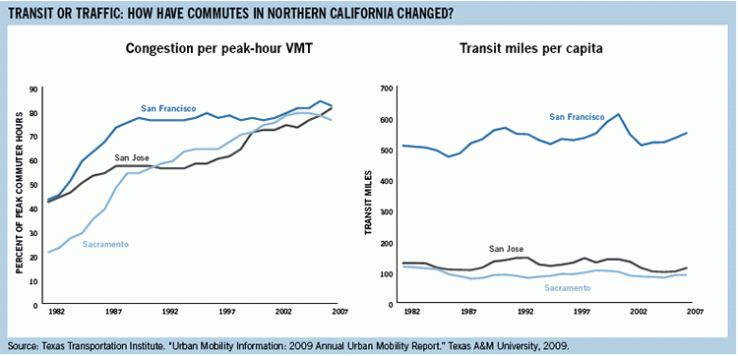 Increasing congestion has been a consistent feature in Northern California commutes. Not surprisingly, the total transit ridership per capita has scarcely changed. With future population growth, just maintaining our current high levels of congestion will require shifting many more people and jobs to places served by transit. <!--EndFragment-->
Increasing congestion has been a consistent feature in Northern California commutes. Not surprisingly, the total transit ridership per capita has scarcely changed. With future population growth, just maintaining our current high levels of congestion will require shifting many more people and jobs to places served by transit. <!--EndFragment-->
How to solve job sprawl
While reinforcing traditional downtowns is a key goal of the megaregional planning agenda, suburban job locations increasingly are a part of our economic landscape and thus invariably a part of the solution. Job sprawl cannot be stopped or reshaped without acknowledging this and finding a way to make more suburban jobs transit-accessible.
We propose four solutions:
- Put more jobs into existing transit-rich downtowns.
- Shift more work to suburban transit-served employment centers, often in or near "edge cities."
- Remake multi-tenant suburban office parks and scattered office buildings along highways corridors (our "edgeless cities") into more clustered, transit-served destinations.
- Redesign the corporate campus to accommodate significantly more work and to further reduce drive-alone rates.
All four of these land-use approaches are necessary to reduce the harmful impacts of job sprawl. But each also has limitations.
Solution #1: Put more jobs into existing downtowns with high transit ridership.
First, the simplest solution is to create more jobs and encourage more businesses to be situated in downtowns that already have high transit ridership, mixed uses, mobility and infrastructure. This was the argument SPUR made in its "Future of Downtown" policy paper. In Northern California, San Francisco and Oakland are the best examples of downtowns with healthy transit ridership: San Francisco has more than 50 percent and Oakland around 24 percent. Downtown Sacramento and San Jose trail significantly, but are ideal places to add jobs, particularly because both are investing heavily in transit and asserting themselves as the economic and cultural centers of the surrounding areas.
The key to making this model work is the right combination of transit infrastructure, market-based parking pricing, good urban design, a well-maintained pedestrian environment and, depending on the city, the overcoming of other non-physical business-climate issues — such as perceptions about Oakland’s public safety or San Francisco’s costs.
This approach is easier said than done.4 It is very rare in American urbanism to successfully restore a continuous pedestrian fabric to central city landscapes that have already lost their historic buildings and replaced them with blank facades and surface parking lots, but that is the ambitious planning agenda we call for. This approach also requires significant investment in peak-hour transportation infrastructure, keeping in mind that it is generally less costly than the auto-centric infrastructure required by other employment models. The successful central business district model of good transit and a pedestrian environment with limits on parking is the most successful and proven way to get commuters out of their cars.
While some may argue that the idea of shifting more jobs back downtown is an attempt to return to the pre-automobile pattern of the early 20th century, when each region had a more monocentric form with a single large downtown, our notion actually is more of an acceptance of the polycentric form of the contemporary region. Given the three types of downtowns considered in this essay, the solution of adding more jobs to downtowns results in a widely differentiated set of transit-served downtowns that range from Oakland to Berkeley to San Mateo to San Rafael.
But today, this model must coexist with other ways of organizing work.
Solution #2: Channel more suburban jobs into transit-served nodes and edge cities.
The second-best locational solution to job sprawl is to shift more employment adjacent to rail or regional transit stations in the suburbs. Suburban transit-oriented development nodes are emerging and have created the foundation for increased transit commuting to suburban job destinations. This can be achieved through a variety of strategies, such as building on surface parking lots next to stations, rezoning nearby areas and reworking the street grids, and ultimately by influencing more businesses to locate near these established nodes.
There are some drawbacks to the suburban transit-oriented development approach. Even a successful suburban job center likely will not approach the density levels of a traditional downtown, and thus it will be hard to achieve high transit ridership. Further, commuters will be coming from scattered places, thus making it easier and faster to go from home to work via car, even if work is at a suburban TOD. Ultimately, the level of transit ridership to these places will be based on the availability and price of parking at the job center, the pedestrian experience from the station to work, and the density and transit accessibility of the commuters’ homes.
Solution #3: Create denser suburban job corridors.
The third locational solution is to remake existing car-oriented employment centers. These places are the low-density office, lab, retail and industrial spaces that spread along or near highway corridors and proliferate throughout suburbia. The places include buildings such as the Zhone headquarters along I-880 or Vacavalley Business Park. These edgeless areas are the hardest to address, in fact, because their employment densities are low and their employees are spread out. Additionally, in some places the land values are low, thus making it harder to increase densities.
Some of these edgeless cities do not have any rail transit today, but may be getting close to appropriate levels to support it. According to a well-known 1977 study, 8,000 people per square mile is the minimum residential density necessary to support rail investment.5
Solution #4: Reimagine the corporate campus.
The fourth locational solution is about remaking the traditional corporate campus, which is typically a relatively dense job center with a single tenant. There are several ways to accomplish this. First, there should be an expansion of the successful shuttle programs of employers such as Genentech, Apple and Google. For example, as many as 50 percent of workers employed at these companies (who live in San Francisco) take shuttles to work. This rivals the share of commuters taking transit to downtown San Francisco.
Second, there should be an increase in the number of jobs at each campus by building on the seas of parking and landscaping that surround existing buildings. With less parking, companies could begin to charge for parking and provide the revenue to transit commuters. Less parking and landscaping is also a cost-saver to the company. As employment density increases over time, new transit could be brought to the campus.
Third, the self-enclosed design should be opened and better integrated with the surrounding community. University campuses remain places of innovation and intellectual protection while also being more open to outsiders. This remaking of the campus could also involve integration of other uses such as retail and even housing to the campus and the areas immediately around it.
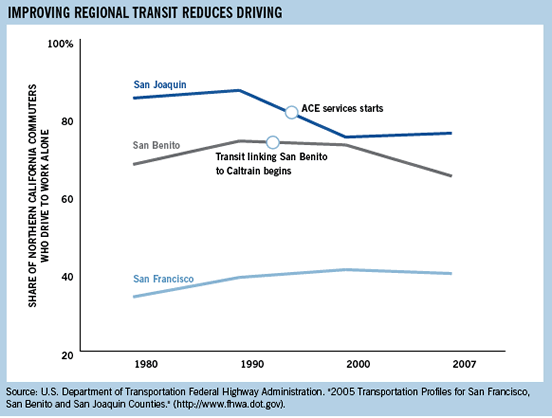
The number of Northern California commuters who drive alone to work has been steadily increasing since the 1980s, except in areas where regional transit access has been improved. For example, after the creation of the Altamont Commuter Express (ACE), transit ridership in San Joaquin county rose by 1,137 people daily. Similarly, when Caltrain was extended to Gilroy in Southern Santa Clara County — with shuttles linking San Benito to the station — ridership in San Benito jumped from 302 to 2,248 commuters per day. <!--EndFragment-->
Conclusion
As this article argues, solving job sprawl does not involve a single approach. We live and work in a polycentric region with a wide range of employment locations, each with a slightly different opportunity to capture future job growth. We also cannot be naíve and assume that the traditional central business districts will regain a majority share of regional jobs, even if this would be the most effective strategy to reduce overall driving. But we certainly can push to make sure that employment throughout the region shifts to more appropriate places. This strategy is the only viable approach to solving the worsening challenge of job sprawl, which in turn is one of the major causes of residential sprawl. Over the next year, SPUR will explore this issue further, refining its approach and developing policy solutions. If we are serious about stopping sprawl, we need to be just as focused on jobs as we are on housing.
ENDNOTES
1 See "Recentering Work: The Future of Downtown San Francisco," March 2009, where we argued for channeling job growth into transit-rich cores, like downtown San Francisco.
2 We are focused primarily on office sprawl. While many jobs in an economy do not require offices (retail, distribution, construction, production, etc.), the majority of work in the megaregion is directly tied to an employment center that is primarily a collection of office buildings.
3 Kneebone, Elizabeth. "Job Sprawl Revisited: The changing geography of metropolitan employment." Brookings, 2009.
4 An example from the City of Oakland demonstrates the challenge of increasing parking prices. When prices were raised to help fill a budget hole, local businesses staged a strike by shutting down their businesses, thus forcing the City Council to reverse the parking rate increases indefinitely. While well intentioned, this approach of ramping up parking costs can backfire if residents and local business owners perceive the increase to be more about paying local salaries and less about managing congestion or ensuring that there is always a free parking space. Reversing a poorly executed increase in parking prices can push back an improvement to parking management for years.
5 See: Pushkarev, Boris S. and Zupan, Jeffrey M. Public transportation and land use policy, 1977.
